The premise is simple: read one comic every day for the entire year. It seems like a simple task but there is no way that I read 365 comics last year, even if you count the individual issues in collections. So, this year, I am committing myself to this reading challenge, in the hope that I can broaden my reading habits and fully engage with my favorite hobby again.
While I gather the comics for the continuation of my exploration of adaptation and comics, I’m having an easy read week. Luckily, I’ve just sorted out my British Weeklies from the 1980’s and early 1990’s, so I can spend all week reading The Transformers. (If you’re not a fan, I suggest skipping this week, because I really am going to be reading The Transformers all week, I have over 300 of the original Marvel UK weekly/fortnightly comics to get through)
Firstly, a bit of history. When The Transformers comic first came out in 1985, my friend was collecting it while I used my pocket money for other titles such as Spider-Man. All of the comics we bought were published through Marvel’s semi-independent British offices and therefore packaged differently to the American originals. Most titles had a main feature story with a back-up strip from one of Marvel’s lesser known titles. So it was through The Transformers that I was introduced to Rocket Raccoon, Hercules, and Machine Man.
Back then, we used to buy several comics in a week, take them to school and lend them to friends. When my friend switched from reading The Transformers to Action Force (the British title for GI Joe) we swapped our collections. A few years later, I got Action Force back but I can’t remember what I swapped in return. The Transformers was an instrumental title in introducing me to the world of comics and what they could do. The mix of American reprint stories and the new British “fillers” (required because the UK title would constantly get ahead of its American counterpart) gave me an insight into two very different worlds of storytelling. Writer Bob Budiansky’s initial output, designed to advertise Hasbro’s range of new toys, were adventurous war stories that often had a human character central in the narrative. Simon Furman’s, on the other hand, were science fiction heavy, and the messages were more complex and ambiguous. It was like reading 2000AD and the 1970s Avenger comics mixed together in an uncomfortable cooking pot.
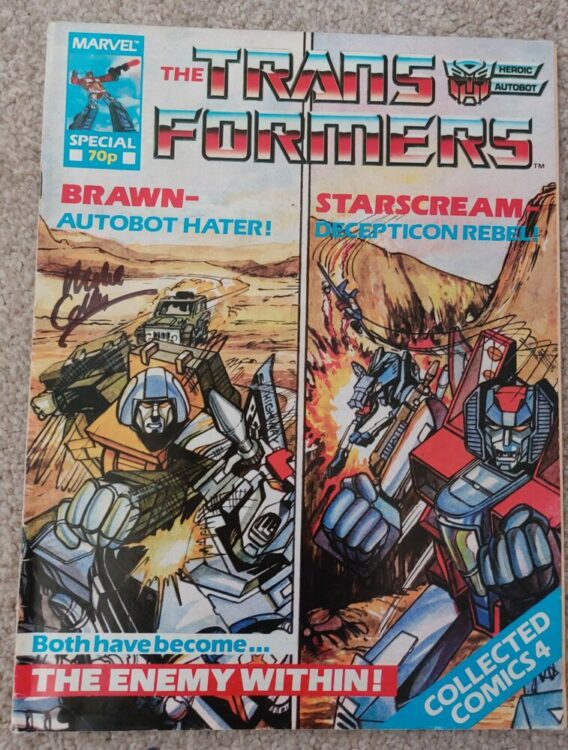
Comic Number 71: The Enemy Within
Simon Furman weaves a tale of treachery and physiological imbalance in a story that ends with a pitched battle between the overworked Autobot named Brawn and the backstabbing Decepticon, Starscream.
The story first appeared as a black and white strip in issues 13 to 17 of the fortnightly comic and was later reprinted in full color. Gina Hart provided the colors and her bright, painterly style is fixed in my memory of early Transformers comics. John Ridgeway’s dynamic artwork is brought to life by Hart’s work and I favor the collected edition more than the original.
The story appears very simple: two outcasts, one from each side of the war, battle each other to prove themselves to their respective leaders. But underneath, Furman packs the narrative with moral quandaries and a surprising amount of violence.
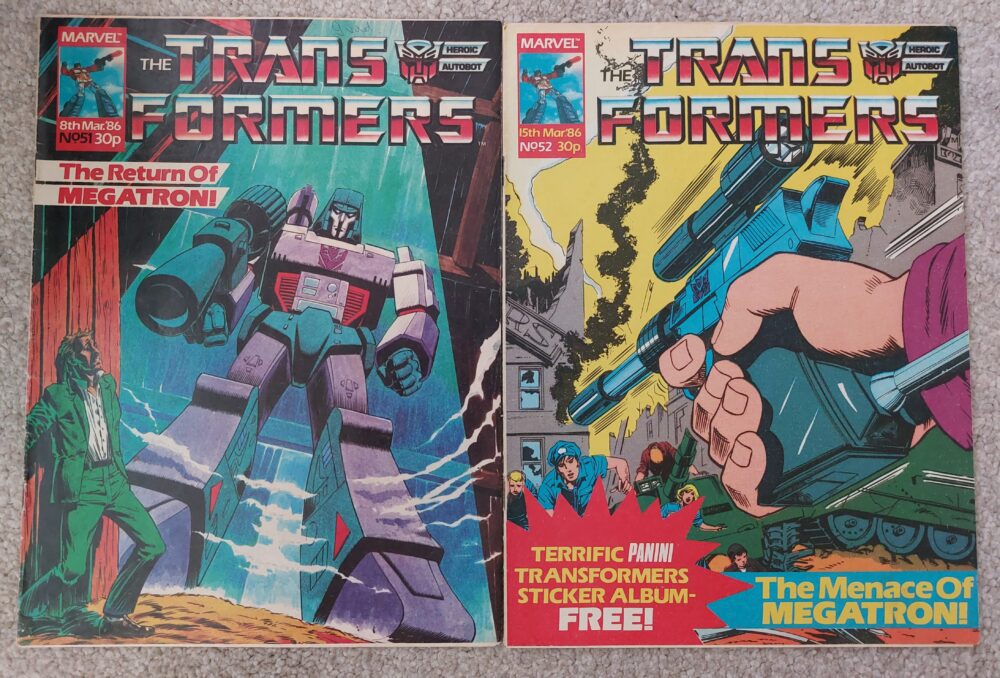
Comic Number 72: Shooting Star
My second pick from the stack of reads is a reprint of an American story and first published in the UK in issues 51 and 52 (issue 13 of the American title). The story is actually Transformer lite featuring Megatron in his gun mode for the majority of it and few appearances of other giant robots. Written by Bob Budiansky, the narrative follows Joey Slick and his rise from cheap hood to a kingpin of crime, thanks to the off world power of Megatron.
The small amount of Transformer action allows Budiansky to indulge in a crime comic clearly inspired by the early 1950’s titles. It has the low life beginnings for Joey, that just aren’t quite enough to justify the violence that follows. This is followed by pages of violence, cruelty, excess, and the disregard for people that made crime comics a target for outraged organizations in the 1950’s. And in the end, a few panels to show that Joey is punished for his life of crime. A small redemption is thrown in to make Joey appear heroic but ultimately Shooting Star is about a mobster using one of the most evil leaders in the universe to rob banks. What’s not to like?
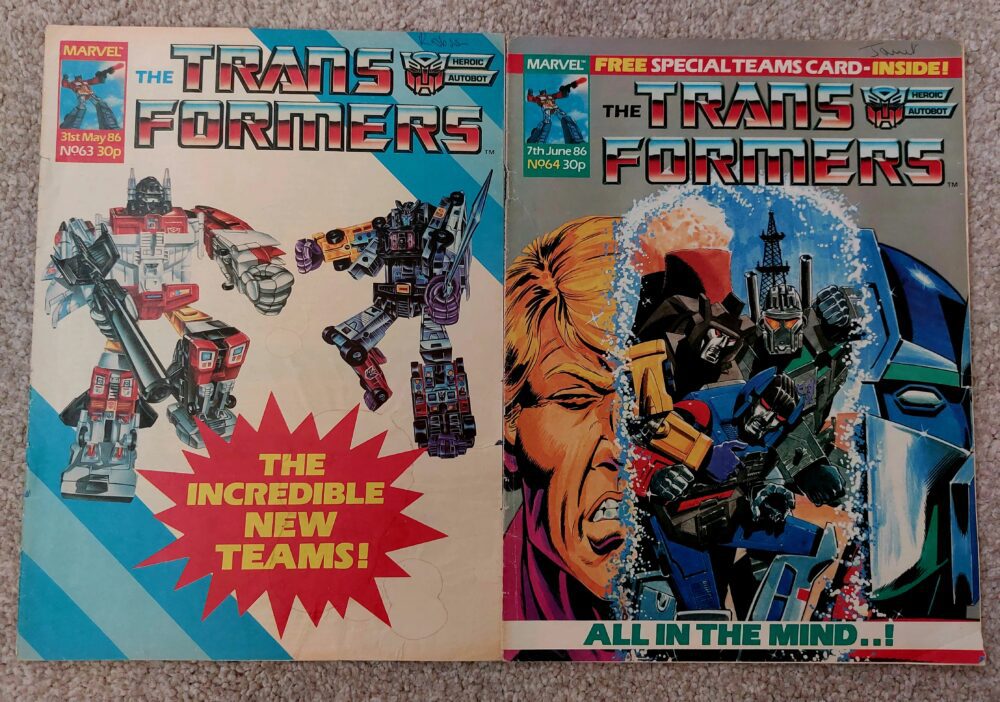
Comic Number 73: Second Generations
First published in issues 63 and 64, these were the first two Transformers comics I bought with my own money. Issue 63 has one of the funniest Robo-Capers strips (in my opinion) by the British humorist Lew Stringer and a text piece summing up the story so far. If you hadn’t read any of the previous 62 issues then this would be the perfect jumping on point.
However, comics were a bit different back then and it wasn’t that difficult to get into any of the issues. The stories were a lot more episodic and when they were split across multiple issues there was always a recap. More often than not, any important backstory information was written directly into the comics themselves so any new reader wouldn’t be left in the dark. This is an art form that I think is lacking from many new comics, especially those put out by the Big 2 publishers.
Anyway, Second Generations was written by Simon Furman (who wrote most of the UK stuff and eventually jumped the pond to write for the American title as well), illustrated by John Stokes with Mike Scott and J Firmin. The most notable aspect of this story is that it clearly a marketing ploy for the new range of toys being released at the time. The Transformers was originally a four issue mini-series devised between Hasbro and Marvel to advertise a toy range. As the series developed, that initial raison d’etre was still present within the pages for years to come. However, it never seemed to diminish the storytelling. In fact, I would argue it made the writers and artists more creative as they had to find ways to introduce characters whose designs were dictated by a toy company based on molds bought from another country. In some respects, it’s surprising the stories are as good as they are.
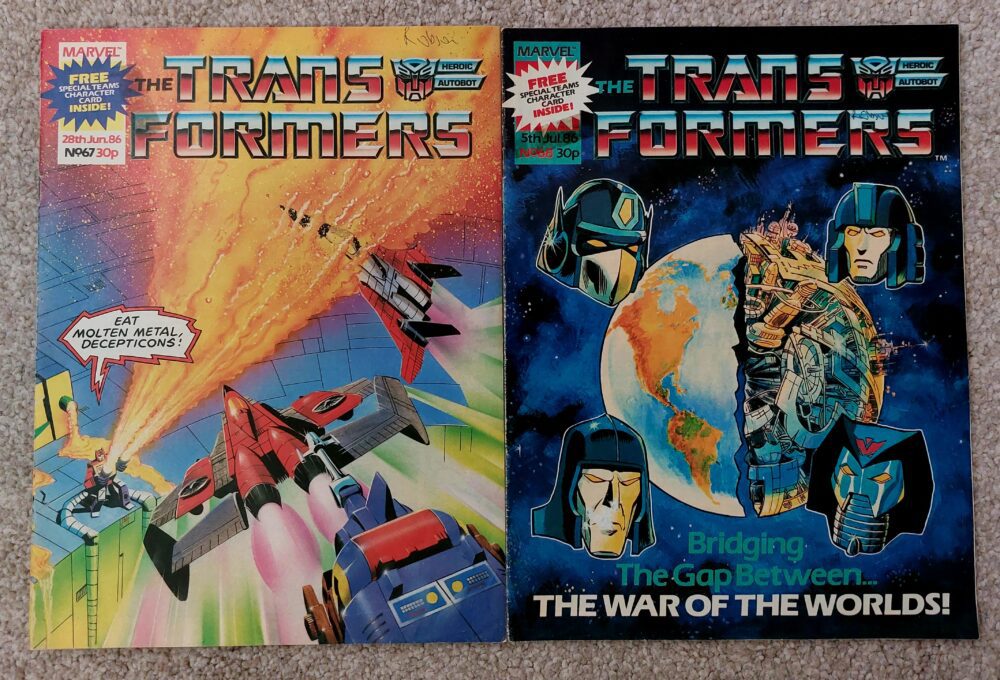
Comic Number 74: The Smelting Pool and The Bridge to Nowhere
This two-parter is just pure science-fiction fun. The story returns to Cybertron and introduces a host of new characters. Some don’t last too long, such as the Autobot spy Scrounge, while others become mainstays in the series. Introduced among the ranks are one of my favorite Autobots, Blaster (the good guy version of Soundwave) and one of the strangest Decepticon leaders, Straxus. Straxus was nasty. Evil in robot form. And his story-line appears to end in this two part story but that’s not the case. In fact he becomes instrumental in future story-lines, in the weirdest ways.
Again, these American reprint issues are written by Bob Budiansky, this time with Don Perlin, William Colletta, Janice Chiang, and Nel Yomtov providing the art work. Apart from the pure enjoyment factor, these two issues also open up the narrative, creating a link between two worlds and an infinite host of new characters.
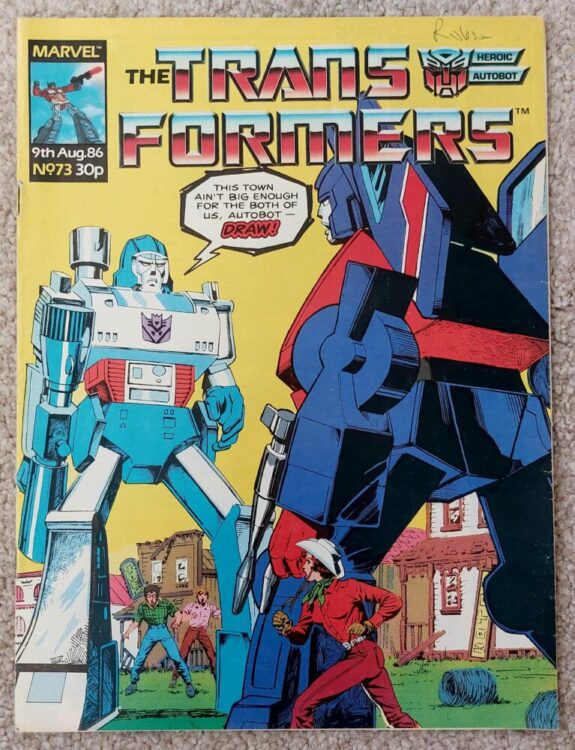
Comic Number 75: Showdown
As if wanting to prove that any genre could be covered by giant robots at war, Showdown in issues 72 and 73 (reprinted from issue 20 of the American comic) is stuffed with western tropes.
Skids runs away from the Autobots, sick of the violence, and takes up residence with Charlene, a human who becomes infatuated with him. Unfortunately, their peaceful co-existence doesn’t last long when Ravage turns up and attacks Skids. There is also an added element of danger; a road rage human who wants to trash Skids because of a small altercation between them in an earlier issue.
This is another fun, at times daft, story that can’t help to entertain. There are some undercurrents of greater meaning and moral discussion but the heavy handed coating buries the messages deep. There’s nothing groundbreaking here but what do you want from a comic created to sell toys of giant robots?
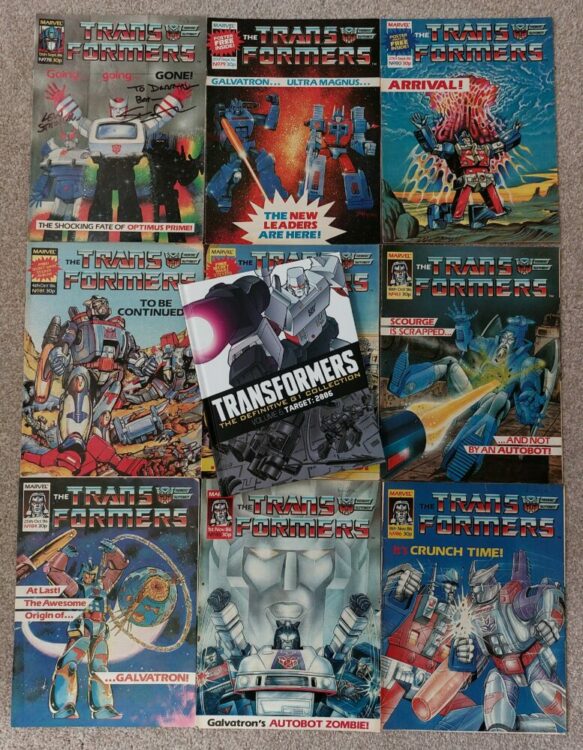
Comic Number 76: Target: 2006
This is where it changes. This is the story that trapped me in The Transformers world and cemented my love of comics. I have read and re-read this story so many times, I’ve lost count but will always read it again.
In issue 78, on 13 September 1986, Simon Furman and Jeff Anderson introduced the British comics reading public to Galvertron, over two months before Transformers: The Movie would officially introduce the character into continuity. At the time the American writers had decided that they weren’t going to use any of the new characters from the movie so Furman was given free reign and the story he produced, Target: 2006, is an absolute blinder.
In the Prologue, three Autobots — Ratchet, Prowl, and Optimus Prime — disappear in an almighty flash, leaving nothing but black scorch marks. Elsewhere three brand new Decepticons appear on the scene, proclaiming to have traveled back 20 years in time. Imagine being 10 years old and reading this introduction to a story. The seeming death of three major characters. The introduction of three new characters. Time travel! And the story just gets better over the next 10 issues. Furman introduces time paradoxes, leadership struggles, the destruction of hope, allegiances with evil, and zombie Jazz! (that’s a possessed Transformer, not a type of music). It really does have it all.
It’s also interesting to see that when the prologue was written and drawn, the creators had not seen the designs for the characters from the movie. Therefore, at the end, when Galvatron and his lieutenants make an appearance, they are based on the toy designs, not the cartoon designs. This is then changed for Part 1 of Target: 2006 in issue 79.
Target: 2006 is an epic narrative superbly written and has a long lasting influence on the ongoing saga. As is noted in Volume 6 of the Complete G1 Collection, the movie “ticked all the right boxes, and its darker tone [..] was a perfect fit for the Marvel UK Transformers comic.” Simon Furman took the characters and premise of the movie and produced one of my all time favorite comic stories. I still blame Target: 2006 for my ever growing obsession with this medium.
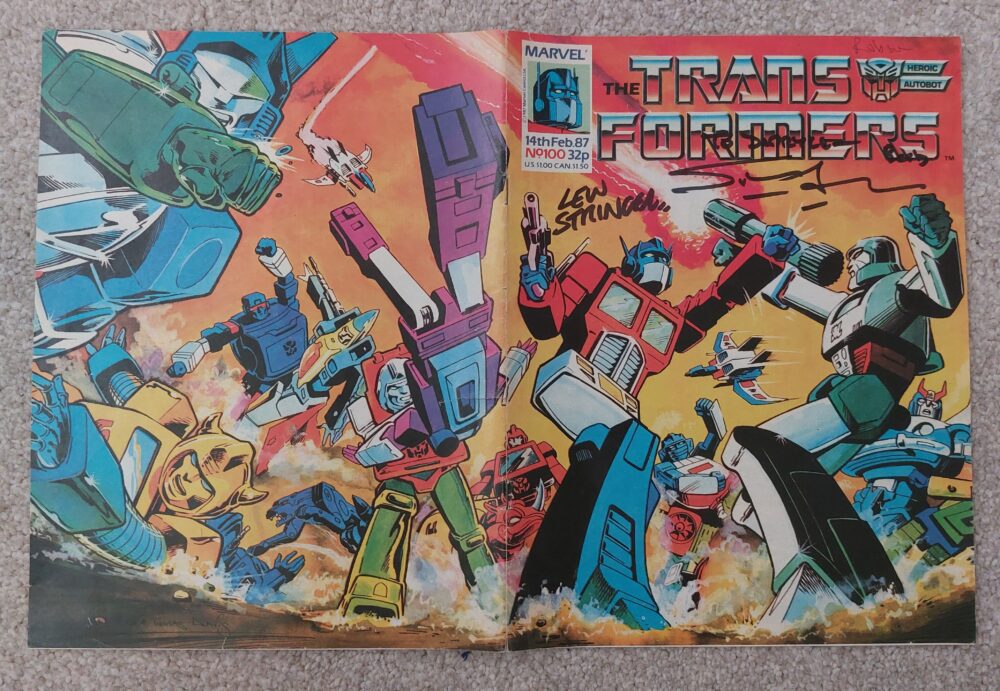
Comic Number 77: Distant Thunder (Issue 100)
What happened to Optimus Prime when he was ripped out of time at the start of the Target: 2006 story-line? Where did he, and the other displaced characters, end up? Well, in the 14 February 1987 issue, Simon Furman lets the readers into the secret.
Distant Thunder is a morality tale told by Optimus Prime to his dying comrade, Outback. In the previous issue Outback is fatally wounded and Prime is forced to sit with him while he dies. The tale within a tale is a dissection of the nature of violence, while the book-ending narrative is touching and even heartbreaking. No mean feat for a comic about giant shape changing robots on an impossible planet. And we’re only a third of the way through Marvel UK’s ongoing series.
Apparently I didn’t get through as many of these comics as I thought I would this week. To be honest, I thought I would skip over many of them and just pick out some of my favorite story-lines but it seems I like more of them than I remember.
I am continuing to read my box of Marvel UK Transformers comics (which dropped its “The” from the title with issue 200) and will no doubt drop a few of the stories into future articles. Because, I know what’s coming, and there are some outstanding comics in there.
Do you have any childhood favorites that you still continue to re-read today? If so, let me know in the comments below, maybe we can share some memories.

